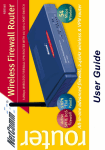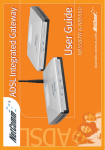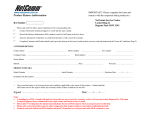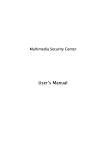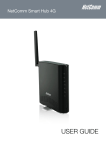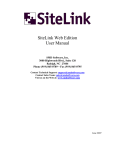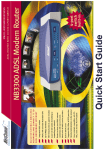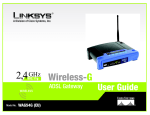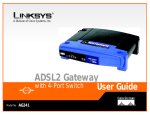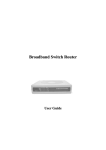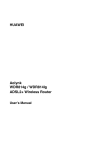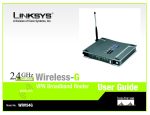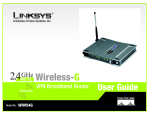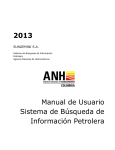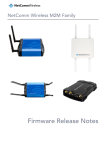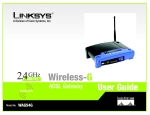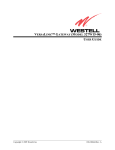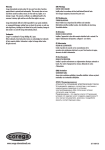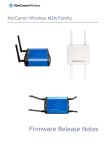Download YML630 Rev3 Firewall Router
Transcript
Contents Default Settings & Facts ........................................................................................... 4 NetComm Cable/DSL Firewall Router Quick Start .................................................. 5 One page setup for Telstra Bigpond Cable ........................................................ 6 One page setup for Optus Cable ........................................................................ 7 One page setup for most ADSL services ........................................................... 8 Introduction ................................................................................................................. 9 Chapter 1: Getting to know your NetComm Cable/DSL Firewall Router ................ 11 1-1 About NetComm Cable/DSL Firewall Router .............................................. 11 1-2 Contents of the NetComm Cable/DSL Firewall Router Package ............... 12 1-3 Features of the NetComm Cable/DSL Firewall Router ............................... 12 Chapter 2: Hardware Installation & Setup ............................................................... 13 2-1 2-2 2-3 2-4 2-5 2-6 Rear Panel & Connections .......................................................................... 13 Front Panel LEDs ......................................................................................... 14 System Requirements and Setup ................................................................ 15 Installing the TCP/IP Protocol for Windows ................................................. 15 Fixed IP Addresses Configuration ............................................................... 18 Macintosh Setup ........................................................................................... 20 Chapter 3: Internet Access ....................................................................................... 22 3-1 Prepare your network information ................................................................ 22 3-2 Web-based User Interface ........................................................................... 23 3-3 Initial Configuration – Setup ......................................................................... 24 Chapter 4: Advanced Applications ........................................................................... 27 4-1 Firewall ......................................................................................................... 27 4-2 DHCP Configuration ..................................................................................... 28 4-3 Access Control ............................................................................................. 29 4-4 Port Forwarding Settings .............................................................................. 30 4-5 Special Application (Port Triggering) ........................................................... 31 4-6 Dynamic Routing .......................................................................................... 32 4-7 Static Routing ............................................................................................... 33 4-8 Administration Settings ................................................................................ 34 4-9 Status Monitor ............................................................................................... 36 4-10 DMZ Host .................................................................................................... 37 4-11 Log .............................................................................................................. 38 4-12 VPN Passthrough ....................................................................................... 38 4-13 Dynamic DNS (DDNS) ............................................................................... 39 4-14 Universal Plug and Play ............................................................................ 40 4-15 Back Up and Restore ................................................................................ 44 4-16 Diagnostics ............................................................................................... 47 www.netcomm.com.au Page 2 Rev.3 - YML630 Cable/DSL Firewall Router Chapter 5: Configuring IPSec/VPN Tunnels ........................................................... 49 5-1 VPN/IPSec Introduction ................................................................................ 49 5-2 VPN Application Types .................................................................................. 51 5-3 VPN / IPSec Setup ........................................................................................ 52 5-4 Example1: Tunnel between Two VPN Routers ............................................ 56 5-5 Example2: Tunnel between VPN Router-and-VPN Client with Fix IP ............................................................................................................ 56 5-6 Example3: Tunnel between VPN Router-and-VPN Client with dynamic IP ................................................................................................... 57 Chapter 6: Configuring IPSec on Windows 2000/XP .............................................. 58 6-1 Environment ................................................................................................. 58 6-2 Steps in Windows 2000/XP .......................................................................... 58 6-3 Steps in Cable/DSL Firewall Router ........................................................... 70 Chapter 7: Trouble Shooting .................................................................................... 72 Hardware ............................................................................................................ 72 Client Side (Computers) ..................................................................................... 73 Appendix A: Frequently Asked Questions ................................................................ 74 Appendix B: Technical Specifications ...................................................................... 76 Appendix C: Glossary ............................................................................................... 78 Appendix D: Updating your Firmware ...................................................................... 81 Appendix E: Examples of Using your Router with File Sharing Programs and Web Servers ....................................................................... 82 Appendix F: Security ................................................................................................. 83 Appendix G: Registering your NetComm Product ................................................... 84 Contact Information ............................................................................................ 84 Trademarks and Notices .................................................................................... 84 Product Warranty ................................................................................................. 87 Limitations of Warranty ....................................................................................... 87 Rev.3 - YML630 Cable/DSL Firewall Router www.netcomm.com.au Page 3 Default Settings & Facts The following lists the default settings of your NetComm Cable/DSL Firewall Router. Note: It is highly recommended that you enable security settings in the router before connecting your router to your network. Router LAN IP: 192.168.1.1 Username: <none> Password: admin WAN port MDI: Auto MDI (No cross over cable required) Resetting While using or installing your NetComm Cable/DSL Firewall Router you may need to utilise the reset feature. There are two types of reset: Soft A soft reset will restart the unit and reconnect to the internet using the settings stored previously, none of your settings are deleted. To perform a soft reset briefly press the reset button on the back of the unit. Hard A hard reset will return your unit to its factory default setting, meaning that you will loose all configurations and logs set/stored previously. To perform a hard reset, press and hold in the reset button on the back of the unit for 10 seconds. Power Ensure that you only use the Power Adaptor supplied (5V DC, 3amps, Center pole positive) with your NetComm Cable/DSL Firewall Router. Contact Information If you have any technical difficulties with your product, please do not hesitate to contact NetComm’s Customer Support Department. Email: [email protected] Fax: (02) 9424-2010 Web: www.netcomm.com.au www.netcomm.com.au Page 4 Rev.3 - YML630 Cable/DSL Firewall Router NetComm Cable/DSL Firewall Router Quick Start The following Quick Start pages are intended to be used by an advanced user to quickly configure the NetComm Cable/DSL Firewall Router. It assumes that you are familiar with Networking and that you already have a Cable or ADSL modem with an Ethernet port. If you need further explanation, please refer to the more detailed sections of this document. This guide presumes that your NetComm Cable/DSL Firewall Router is set to factory defaults (See Resetting on previous page if required). Rev.3 - YML630 Cable/DSL Firewall Router www.netcomm.com.au Page 5 One page setup for Telstra Bigpond Cable 1. Connect your computer to one of the four LAN ports on the NetComm Cable/DSL Firewall Router and ensure you have a link. Connect your Cable modem (supplied by your ISP) to the WAN port of the NetComm Cable/DSL Firewall Router. 2. Set the Network Card of your computer to use DHCP or assign it an IP address in the range of 192.168.1.2 ~ 254. 3. Open a web browser (ensuring that it is set to access the Internet via the LAN, not by a dialup networking account). Browse to the NetComm Cable/DSL Firewall Router's default IP (192.168.1.1). The main menu of the router should open displaying the “One Page Setup”. Note: You may be prompted for a log-in, there is no User Name and the Password is "admin". 4. Change your “WAN Connection Type” to “Heartbeat (E.g. Telstra cable)”. 5. Set your “User Name” and “Password” as provided by your ISP. 6. If you wish to make services available to external Internet users, even when you are not using Internet services from inside your network, you can choose “Keep Alive”. Alternatively for extra security you can choose “Connect on Demand”. 7. Click “Apply”. Your NetComm Cable/DSL Firewall Router will attempt to use your settings to connect to your ISP. You can check the results on the “Status Monitor” page. 8. If you have a DHCP server already active on your network it is recommended that you disable either the NetComm Cable/DSL Firewall Router's built in DHCP server or the existing DHCP server. Please note that Microsoft Internet Connection Sharing is a DHCP server. www.netcomm.com.au Page 6 Rev.3 - YML630 Cable/DSL Firewall Router One page setup for Optus Cable 1. Connect your computer to one of the four LAN ports on the NetComm Cable/DSL Firewall Router and ensure you have a link. Connect your Cable modem (supplied by your ISP) to the WAN port of the NetComm Cable/DSL Firewall Router. 2. Set the Network Card of your computer to use DHCP or assign it an IP address in the range of 192.168.1.2 ~ 254. 3. Open a web browser (ensuring that it is set to access the Internet via the LAN, not by a dialup networking account). Browse to the NetComm Cable/DSL Firewall Router's default IP (192.168.1.1). The main menu of the router should open displaying the “One Page Setup”. Note: You may be prompted for a log-in, there is no User Name and the Password is "admin". 4. Change your “WAN Connection Type” to “Obtain an IP automatically (E.g. Optus cable)”. 5. Optus cable does not require a “User Name” and “Password” as it uses the modem's MAC address to identify you to your ISP. 6. If you wish to make services available to external Internet users, even when you are not using Internet services from inside your network, you can choose “Keep Alive”. Alternatively for extra security you can choose “Connect on Demand”. 7. Click “Apply”. Your NetComm Cable/DSL Firewall Router will attempt to use your settings to connect to your ISP. You can check the results on the “Status Monitor” page. 8. If you have a DHCP server already active on your network it is recommended that you disable either the NetComm Cable/DSL Firewall Router's built in DHCP server or the existing DHCP server. Please note that Microsoft Internet Connection Sharing is a DHCP server. Rev.3 - YML630 Cable/DSL Firewall Router www.netcomm.com.au Page 7 One page setup for most ADSL services 1. Connect your computer to one of the four LAN ports on the NetComm Cable/DSL Firewall Router and ensure you have a link. Connect your ADSL modem (supplied by your ISP) to the WAN port of the NetComm Cable/DSL Firewall Router. 2. Set the Network Card of your computer to use DHCP or assign it an IP address in the range of 192.168.1.2 ~ 254. 3. Open a web browser (ensuring that it is set to access the Internet via the LAN, not by a dialup networking account). Browse to the NetComm Cable/DSL Firewall Router's default IP (192.168.1.1). The main menu of the router should open displaying the “One Page Setup”. Note: You may be prompted for a log-in, there is no User Name and the Password is "admin". 4. Change your “WAN Connection Type” to “PPPoE (ADSL)”. 5. Set your “User Name” and “Password” as provided by your ISP. 6. If you wish to make services available to external Internet users, even when you are not using Internet services from inside your network, you can choose “Keep Alive”. Alternatively for extra security you can choose “Connect on Demand”. 7. Click “Apply”. Your NetComm Cable/DSL Firewall Router will attempt to use your settings to connect to your ISP. You can check the results on the “Status Monitor” page. 8. If you have a DHCP server already active on your network it is recommended that you disable either the NetComm Cable/DSL Firewall Router's built in DHCP server or the existing DHCP server. Please note that Microsoft Internet Connection Sharing is a DHCP server. www.netcomm.com.au Page 8 Rev.3 - YML630 Cable/DSL Firewall Router Introduction Congratulations on your purchase of the NetComm Cable/DSL Firewall Router. The NetComm Cable/DSL Firewall Router is designed to provide advanced networking security and network resource sharing, utilising fast Ethernet connections with four built-in 10/100 auto-sensing switched Ethernet ports. And best of all, with a powerful firewall engine, this device is able to prevent DoS attack and uses SPI to provide superior protection for your private network from Internet hackers. The built-in NAT provides a natural Internet firewall, protecting your network from unauthorised access by outside users. The router will share your internet connection with up to 253 users. Configured as a DHCP server, the NetComm Cable/DSL Firewall Router assigns an IP Address to every computer connected on the LAN automatically. Also, a DHCP client helps the WAN port to acquire an IP address dynamically from your ISP. Unlike other typical routers, which only share 10Mbps over all of their connections, the NetComm Cable/DSL Firewall Router is equipped with a 4-port 10M/100Mbps auto-sensing switch, dedicating a possible100Mbps to each and every ethernet connected computer. With a web-based UI (User Interface), this NetComm Cable/DSL Firewall Router is easy to setup and maintain via web browsers such as Netscape Communicator and Internet Explorer. Rev.3 - YML630 Cable/DSL Firewall Router www.netcomm.com.au Page 9 About this Guide This guide contains information about installing and configuring your NetComm Cable/DSL Firewall Router. It is designed to guide users through the correct setup procedures for both hardware installation and basic configuration. Later, it shows how to complete advanced configuration to get the best operating performance from the NetComm Cable/DSL Firewall Router. Chapter 1: Get to know your NetComm Cable/DSL Firewall Router This chapter describes the package contents and provides a list of features of the NetComm Cable/DSL Firewall Router. Chapter 2: Hardware Installation & Setup This chapter describes the steps for hardware installation of the NetComm Cable/DSL Firewall Router. Chapter 3: Internet Access This chapter describes the steps for basic configuration and start up of the NetComm Cable/ DSL Firewall Router. Chapter 4: Advanced Applications This chapter describes how to configure advanced functions in order to get the most from your NetComm Cable/DSL Firewall Router. Chapter 5: Configuring IPSec VPN This chapter describes IPSec VPNs and explains how to configure your Router. Chapter 6: Configuring IPSec on Windows 2000/XP This chapter describes how to configure IPSec on Windows 2000/XP Chapter 7: Trouble Shooting This chapter describes potential problems you may run into and the suggested remedies. Conventions The following explains the conventions used throughout this document. Italics New words, terms, or special emphasis. E.g. Getting to know your NetComm Cable/DSL Firewall Router. “Boldface” Buttons, checkboxes, or items that you can select from screens, menus, or dialog boxes. E.g. Click “OK” to restart Boldface Italics www.netcomm.com.au Page 10 Items in Bold Italics are samples only and you should enter other names, numbers, or words to substitute. Rev.3 - YML630 Cable/DSL Firewall Router Chapter 1: Getting to know your NetComm Cable/DSL Firewall Router This chapter describes the package contents and provides a list of features of the NetComm Cable/DSL Firewall Router. 1-1 About NetComm Cable/DSL Firewall Router The NetComm Cable/DSL Firewall Router is a hybrid product, which combines Ethernet technology with a firewall engine into a single stand-alone unit. The device allows you take advantage of both security and fast connections. All computers on your LAN can securely share files, printers and other network resources, as well as a single Internet account when connected to a DSL/Cable modem. Ethernet / Fast Ethernet Ethernet is the most widely-used network access method, especially in LANs. It is defined by the IEEE as 802.3 standard. Normally, Ethernet is a shared media LAN. All stations on the segment share the total bandwidth, which could be 10Mbps (Ethernet), 100Mbps (Fast Ethernet), or 1000Mbps (Gigabit Ethernet). With switched Ethernet, each sender and receiver has the full bandwidth. Fast Ethernet is defined as IEEE 802.3u standard, a high-speed version of Ethernet with 100Mbps transmission rate. Firewall DoS is the acronym for Denial of Service, which refers to the response when a computer or network is overwhelmed to the point that it can no longer function normally. For example, a hacker may use a fake IP address to build connections to flood the server they want to attack. TCP works by sending a SYN packet to the server from the client. After the server receives the SYN packet, a SYN-ACK is sent back to client. The server will then wait for a response to the SYN-ACK. If the hacker sends hundreds of SYN packets to a server with a false address, the server allocates computer and memory resources to establishing a connection - since the server does not know a legitimate SYN message from a false message. By flooding the server with such a large volume of requests, the server’s maximum capacity can easily be used by these false attempts to establish a connection - this is what the firewall is designed to prevent. SPI is the acronym of Stateful Packet Inspection. The SPI engine examines not just the headers of the packet, but also the contents, to determine more about the packet than just its source and destination information. Moreover, stateful inspection firewalls also close off ports until a connection to the specific port is requested. Rev.3 - YML630 Cable/DSL Firewall Router www.netcomm.com.au Page 11 1-2 Contents of the NetComm Cable/DSL Firewall Router Package After carefully unpacking the shipping carton, check the contents listed below: ■ NetComm Cable/DSL Firewall Router ■ Power Adapter - 5VDC 1A Center Pole Positive ■ This Manual 1-3 Features of the NetComm Cable/DSL Firewall Router Your NetComm Cable/DSL Firewall Router contains the following features that make it excellent for network connections. ■ Allows multiple users to access the Internet at the same time by using Network Address Translation to safely share a single public IP Address. ■ Provides network security through a powerful firewall engine. ■ Prevents hackers from launching a DoS attack to overwhelm your LAN computers or server, offering advanced protection with SPI. ■ Blocks inappropriate web sites, cookies and Javascript, if required. ■ Integrates four 10/100BASE-T/TX auto-sensing switch ports. ■ Supports PPPoE to connect to ISPs. ■ Built-in web-based user interface for easy configuration and management through common web browsers like Netscape or Internet Explorer. ■ Supports DHCP client to receive both a dynamic IP Address and a fixed IP Address from your ISP/WAN. ■ Built-in DHCP server to automatically assign and manage LAN IP addresses. ■ Allows administrators to block specific LAN users from accessing specified applications or services. ■ Allows external Internet users to access information from an internal computer (Port Forwarding). ■ Provides unrestricted two-way communication between one computer on your LAN and certain Internet services like conferencing, video and gaming applications. ■ Enhances routing performance by using Dynamic or Static routing. ■ Allows administrators to change WAN MAC address. ■ Compatible with all popular Internet applications. www.netcomm.com.au Page 12 Rev.3 - YML630 Cable/DSL Firewall Router Chapter 2: Hardware Installation & Setup This chapter provides information about your NetComm Cable/DSL Firewall Router’s physical features and gives step-by-step installation instructions. 2-1 Rear Panel & Connections The following figure shows the rear view of the NetComm Cable/DSL Firewall Router and illustrates how the cables connect to the interfaces on the rear panel. Connecting your Router 1. Plug one end of the UTP cable into the WAN port, the other into the RJ45 Ethernet jack on your ADSL or Cable modem. 2. Connect a computer, with a Network Interface Card installed, to one of the four LAN Ports. 3. Connect the external power supply to the NetComm Cable/DSL Firewall Router. 4. The Reset button is used to reboot the device - press once quickly, or for clearing configuration settings back to factory default values - press for 10 seconds. Note: Auto MDI is available on all five ports. A special cross over cable or “uplink” port to join the router to another hub or switch is not required as the ports are self-adjusting. Rev.3 - YML630 Cable/DSL Firewall Router www.netcomm.com.au Page 13 2-2 Front Panel LEDs The following figure shows the front view of the NetComm Cable/DSL Firewall Router. The LEDs on the front panel indicate the status of the unit. Power: Green On when power is on. Diag: Red Lights up during system check when the power is initially connected. If the Router is working properly, the light should switch off after the diagnostic has been completed. Green On when ADSL/Cable Modem is properly connected. WAN ports Link/Act: Green (blink) Blinks during WAN port transmital receive. 10/100: Green On when operating at 100 bps. Yellow On when operating at 10 bps. Green On when ADSL/Cable Modem is properly connected. LAN ports Link/Act: Green (blink) Blinks during LAN port transmital receive. 10/100: Green On when operating at 100 bps. Yellow On when operating at 10 bps. www.netcomm.com.au Page 14 Rev.3 - YML630 Cable/DSL Firewall Router 2-3 System Requirements and Setup To connect to the Internet, an external ADSL or Cable modem and an Internet access account from an ISP are required. In order to operate with the Broadband Switch Router, each computer that is to be connected to the Broadband Switch Router should have the following items installed: 1. Ethernet NIC (Network Interface Card: a 10Base-T or 10/100Base-T/TX Ethernet card). 2. Standard twisted-pair Ethernet cable (UTP network cable) with RJ-45 connectors. 3. System OS: Windows 95, Windows 98, Windows NT4.0, Windows 2000, Windows Me, Windows XP or Macintosh. 4. TCP/IP network protocol. 5. Web browser, such as Microsoft Internet Explorer or Netscape Navigator. 2-4 Installing the TCP/IP Protocol for Windows If you are not sure whether the TCP/IP Protocol has been installed, follow these steps to check, and if necessary, install TCP/IP onto your computer. 1. Click the “Start” button. Choose “Settings”, then “Control Panel”. Double-click the “Network” icon. Your Network window should appear. Select the “Configuration” tab. Rev.3 - YML630 Cable/DSL Firewall Router www.netcomm.com.au Page 15 Note: For Windows 2000 & Windows XP the settings can be reached by clicking the “Local Area Connection” icon on the right bottom side of your desktop screen. In the “Local Area Connection Status” window, click “Properties” button then your Network window will appear. 2. Check whether the TCP/IP Protocol has already been installed and bound to your Network Interface Card. www.netcomm.com.au Page 16 Rev.3 - YML630 Cable/DSL Firewall Router - If yes, go to step 6. - If no, click the “Add” button. 3. Double-click “Protocol” on the Select Network Component Type or highlight “Protocol” then click “Add”. 4. Highlight “Microsoft” under the list of manufacturers. Double-click “TCP/IP” from the list on the right or highlight “TCP/IP” then click “OK” to install TCP/IP. 5. After a few seconds, you will be brought back to the Network window. The TCP/IP Protocol should now be on the list of installed network components (refer to point 2). 6. Click the “Properties” button. Rev.3 - YML630 Cable/DSL Firewall Router www.netcomm.com.au Page 17 The TCP/IP Properties window consists of several tabs. Choose the “IP Address” tab. 7. Select “Obtain an IP address automatically”. Click “OK”. Restart your computer to complete the TCP/IP installation. 2-5 Fixed IP Addresses Configuration Fixed IP addresses may be assigned to network devices for many reasons, such as the server computers or printers which are consistently accessed by multiple users. To set up computers with fixed IP Addresses, go to the “IP Address” tab of the “TCP/IP Properties” window as shown above. www.netcomm.com.au Page 18 Rev.3 - YML630 Cable/DSL Firewall Router 1. Select “Specify an IP address” and enter “192.168.1.***” in the “IP Address” location (where *** is a number between 2 and 254 used by the NetComm Cable/DSL Firewall Router to identify each computer), and the default “Subnet Mask” “255.255.255.0”. Note: No two computers on the same LAN can have the same IP address but they should have the same Subnet Mask. 2. Select “Enable DNS” in the “DNS Configuration” tab and enter the “DNS IP Address” obtained from your ISP in the “Server Search Order” location. Click “OK”. 3. Click “Gateway” tab and enter the NetComm Cable/DSL Firewall Router’s default gateway value 192.168.1.1 in the “New gateway” field, then click “Add” Button. Click “OK”. Restart your computer to complete the TCP/IP installation. Rev.3 - YML630 Cable/DSL Firewall Router www.netcomm.com.au Page 19 2-6 Macintosh Setup This sectopm provides information on using Macintosh computers in your network. The instructions given here are for system software version 8.0 or above, which comes with the TCP/IP Protocol preloaded and supports DHCP Addressing. Hardware Connections Connect your Macintosh computer to your NetComm Cable/DSL Firewall Router. If you have a newer computer, there will be a 10Base-T Ethernet port on the back. Older computers will need to have an Ethernet card installed. Refer to your computer’s User Manual for instructions on Ethernet card installation. Computer Network Configuration It is assumed that your computer’s system software already has TCP/IP installed. You may manually configure your computer with a fixed IP Address (for example 192.168.1.2) or have an IP Address dynamically assigned to it by the NetComm Cable/DSL Firewall Router’s DHCP server. Dynamic IP Addressing using DHCP Server. 1. From the “Apple” menu, select “Control Panel” and click on “TCP/IP”. 2. In the “TCP/IP (A New Name For Your Configuration)” window, select “Ethernet” in the “Connect via” location from the drop-down list. 3. In the “Setup” area: - Select “Using DHCP Server” in the “Configure” location from the drop-down list. - No other data needs to be entered. - Close the window. 4. Click “Save” from the file menu, then “Quit” TCP/IP. 5. Restart the computer. Manual Configuration of Fixed IP Addresses 1. From the “Apple” menu, select “Control Panel” and click on “TCP/IP”. 2. In the “TCP/IP (A New Name For Your Configuration)” window, select “Ethernet” in the “Connect via” location from the drop-down list. 3. In the “Setup” area: - Select “Manually” in the “Configure” location from the drop-down list. - In the “IP Address” location, enter the IP Address that you want to assign to the computer (for example 192.168.1.2) . - Enter “255.255.255.0” in the “Subnet Mask” location. - Enter “192.168.1.1” (the NetComm Cable/DSL Firewall Router’s default IP Address) in the “Router Address” location. www.netcomm.com.au Page 20 Rev.3 - YML630 Cable/DSL Firewall Router - Enter the ISP’s IP Address in the “Name Server” location if your ISP has provided this information. (This is the DNS address provided by your ISP.) - Close the window. 4. Click “Save” from the file menu then “Quit” TCP/IP. 5. Restart the computer. NetComm Cable/DSL Firewall Router Configuration To configure your NetComm Cable/DSL Firewall Router, launch your Web Browser and follow the instructions given in Chapter 3: Internet Access, section 3.3. To configure advanced settings, refer to Chapter 4: Advanced Configuration. Adding NetComm Cable/DSL Firewall Router to Existing Network If the NetComm Cable/DSL Firewall Router is to be added to an existing Macintosh computer network, the computers will have to be configured to connect to the Internet via the NetComm Cable/DSL Firewall Router. 1. From the “Apple” menu, select “Control Panel” and click on “TCP/IP”. 2. From the “File” menu, select “Configurations” and select your existing network configuration. Click “Duplicate”. 3. Rename your existing configuration. Click “OK”, and “Make Active”. 4. In the Setup area: - Select “Manually” in the “Configure” location from the drop-down list. - In the “IP Address” location, enter the IP Address that you want to assign to the computer (for example 192.168.1.2) . - Enter “255.255.255.0” in the “Subnet Mask” location. - Enter “192.168.1.1” (the NetComm Cable/DSL Firewall Router’s default IP Address) in the “Router Address” location. - Enter the ISP’s IP Address in the “Name Server” location if your ISP has provided the information. - Close the window. 5. Click “Confirm”. TCP/IP is now configured for manual IP Addressing. 6. Configure your NetComm Cable/DSL Firewall Router (refer to the above section). Rev.3 - YML630 Cable/DSL Firewall Router www.netcomm.com.au Page 21 Chapter 3: Internet Access This chapter describes the procedures necessary to configure the basic functions and to start up your NetComm Cable/DSL Firewall Router. On successful completion of these procedures, you will be able to access the Internet via your NetComm Cable/DSL Firewall Router. 3-1 Prepare your network information In order to allow a quick reference point when setting up your NetComm Cable/DSL Firewall Router, it is suggested you complete the table below with the necessary information, which should be supplied by your ISP: Provided by some ISPs ( ✓ tick indicates common minimal requirements) Host Name: ______________________________________ Domain Name: ______________________________________ IP address given by ISP: ✓❒ Obtain IP Address automatically, or ✓❒ Static IP IP Address (if static): _________._________._________._________ Subnet Mask: _________._________._________._________ Default Gateway: _________._________._________._________ DNS Server Primary: _________._________._________._________ DNS Server Secondary (optional): _________._________._________._________ DNS Server Third (optional): _________._________._________._________ ✓PPP authentication: ❒ PPPoE ❒ PPTP ✓User Name: ______________________________________ ✓Password: ______________________________________ www.netcomm.com.au Page 22 Rev.3 - YML630 Cable/DSL Firewall Router 3-2 Web-based User Interface The NetComm Cable/DSL Firewall Router uses a Web-based User Interface for configuration. Start your web browser and type http://192.168.1.1 in the browser’s address box. This address is the factory default IP Address of your NetComm Cable/DSL Firewall Router. Press “Enter”. The “Username and Password Required” prompt box will appear. Leave the “User Name” empty and type “admin” (default password) for the “Password”. Click “OK”. The setup screen will load. Note: This password shoudl be changed via the Administration page immediately. The password can be reset by restoring the factory defaults with the Reset button. When making changes to the settings, click on the “Apply” button before moving to another page. The router will reboot and refresh the screen in 5 seconds. Continue the session by selecting more menu items. Rev.3 - YML630 Cable/DSL Firewall Router www.netcomm.com.au Page 23 3-3 Initial Configuration – Setup The “OnePage Setup” screen is the first screen you will see when you access the router’s configuration. If the router has already been successfully installed and set up, this screen’s values will already be properly configured. Below is a description of each setting. ■ Host Name This entry is required by certain ISPs. ■ Domain Name This entry is required by certain ISPs. ■ Time Zone: Select the time zone your location belong to from the pop-down list. ■ Private IP Address The Device IP Address and Subnet Mask of the router are used by the internal LAN. The default values are 192.168.1.1 for IP Address and 255.255.255.0 for Subnet Mask. WAN Connection Type There are a number of options for WAN connection types: Obtain IP automatically (eg Optus Cable), Static IP, PPPoE (ADSL), HeartBeat (eg Telstra Cable) and PPTP. If you do not know which connection type you currently use, contact your ISP to get the information. Obtain IP automatically (eg Optus Cable) Obtain IP automatically is the default option for the router. If your ISP automatically assigns the IP addresses and other values to the NetComm Cable/DSL Firewall Router, use this option. www.netcomm.com.au Page 24 Rev.3 - YML630 Cable/DSL Firewall Router Static IP The Public IP Address and Subnet Mask of the router are used by external users of the Internet (including your ISP). If a fixed Public IP Address from your ISP is to be used, select this item and enter the IP Address and Subnet Mask provided by your ISP. ■ Specify WAN IP Address Enter the IP address provided by your ISP. ■ Subnet Mask Enter the subnet mask values provided by your ISP. ■ Default Gateway IP Address Your ISP will provide you with the Default Gateway IP Address. ■ Domain Name Server (DNS) Your ISP will provide you with at least one DNS IP Address. Multiple DNS IP settings are common. The first available DNS entry is used in most cases. PPPoE If your ISP provides PPPoE connectivity, choose this item from the drop-down list. Note: If you select PPPoE, you will no longer need to use any existing PPPoE applications on any computers to connect to the Internet. ■ User Name Enter the user name as provided by your ISP. ■ Password Enter the password as provided by your ISP. ■ Connect-on-demand Is a utility to trigger the PPPoE session to connect if in a disconnected state when Internet access is being attempted. Choose “Enable” to make this function active, and enter the number of minutes you wish to wait after network idle time in the “Max Idle Time” location. This is the amount of time the router will remain connected after network traffic has ceased. This function is for PPPoE only and is mainly used for security. Rev.3 - YML630 Cable/DSL Firewall Router www.netcomm.com.au Page 25 ■ Keep Alive This function keeps your PPPoE connection always on even during a period of no WAN activity. In some situations the PPPoE session cannot be restored immediately after disconnection because the ISP’s system may need time to restore. Check with your ISP to ascertain how much time is required before the router starts to re-build the PPPoE session and enter this into the “Redial Period” field. HeartBeat If your ISP provides Heartbeat connectivity, choose this item from the drop-down list. ■ User Name Enter the user name as provided by your ISP. ■ Password Enter the password as provided by your ISP. ■ Heart Beat Server When you select the "HeartBeat (eg Telstra Cable)" option for your WAN connection type in the NetComm router One-Page Setup, you may also need to specify the Heart Beat Server's IP address. When you have properly configured the Setup page, click “Apply”. Your Router will then attempt to connect to the Internet. If you experience problems, please refer to the Trouble Shooting section before contacting NetComm Technical Support. www.netcomm.com.au Page 26 Rev.3 - YML630 Cable/DSL Firewall Router Chapter 4: Advanced Applications This chapter provides information on how to set up and use the advanced features of your NetComm Cable/DSL Firewall Router. 4-1 Firewall The Firewall setting page allows you to configure advanced Firewall functions to provide superior security for your network environment. You must click “Apply” to make any changes active. ■ Firewall Option Enable this function to prevent DoS (Denial of Service) attacks and to use SPI (Stateful Packet Inspection). SPI function will check the contents of incoming data packets for malicious attacks. Temporarily disable this option if you have a particularly sensitive Internet application that does not funciton through the router. ■ Web Filter This feature provides the ability to filter potential risks contained in web pages accessed by LAN users. Web proxy is a server your device will connect to when you access any web site. Setting a web proxy can save accessing time but may create a security issue by bypassing any URL filters or IP blocking you have configured. For example, if you configure the Broadband Firewall Router to block the access of 216.115.102.76 that is the IP address of www.yahoo.com, it will fail if your browser is using a proxy because the router only sees the connection to the proxy and then the proxy connects to yahoo. If you block the use of proxies then all connections must be made directly through the router. Java & Active X are programming languages for web pages. However, some Trojan programs are also written in these programming languages. If you deny either of these, you may not be able access some parts of web sites. Rev.3 - YML630 Cable/DSL Firewall Router www.netcomm.com.au Page 27 A cookie is data stored on your computer, which a web server can retrieve to identify your machine. It is a piece of text with an ID number. Cookies can be blocked by the router if the “Deny” option is selected. ■ Blocked URL This feature allows you to restrict LAN users to access specific web sites. Enter the keyword text included in the URLs (Internet address) or whole URLs you wish to block in the fields supplied. For example, if you enter “google” then both www.google.com and www.google.co.uk will be blocked. ■ Time Filter This feature allows you to limit WAN/Internet access according to a time schedule. Check “Block LAN” to restrict the connection from your LAN to the WAN/ Internet. Check “Block WAN” to restrict the connection from the WAN/Internet to your LAN servers that were set as virtual servers, port forwards or DMZ host. Check “Block Both” to restrict both connections. Check “Disable” to turn off this function. Set the time schedule from the drop-down list. Click Apply after making any changes. 4-2 DHCP Configuration A DHCP (Dynamic Host Configuration Protocol) Server can automatically assign IP Addresses and other information to each computer in your network. Unless you already have a DHCP Service on your LAN, it is highly recommended that you set your router to act as a DHCP server. Note: The DHCP Server can support a maximum pool of 253 IP Addresses. ■ Dynamic IP Address Select “Enable” to set your Router to act as a DHCP server. If you already have a DHCP server on your network, set the router’s DHCP option to “Disable”. ■ Starting IP Address Enter a numerical value, from 2 to 254, for the DHCP server to start at when assigning IP Addresses. ■ Number of Users Enter the maximum number of computers that you want the DHCP server to assign IP Addresses to, with the absolute maximum being 253. ■ DNS1, 2, 3 Enter the DNS numbers you wish to be assigned to DHCP clients. ■ WINS Enter the WINS number you wish to be assigned to DHCP clients. ■ DHCP Clients Table Click the DHCP Clients Table button to show current DHCP client information. www.netcomm.com.au Page 28 Rev.3 - YML630 Cable/DSL Firewall Router 4-3 Access Control The Access Control feature allows administrators to block certain users from accessing the Internet or specific applications. Network administrators can restrict access of up to five groups of specified network users/computers.You can indentify users/computers either by IP Address or by MAC Address. To effectively block by IP Address the computers you wish to block must only be able to operate on a fixed IP address and you must know the IP Address of each computer. Alternatively you can identify the computers you wish to block by MAC Address. This is more effective because a MAC Address is physically locked to a computer and not easily changed, however, blocking by MAC address is more laboursome as each filter must be individually set and filtering by MAC address ranges can not be done because MAC addresses are rarely consecutive. ■ Status The Status of the currently selected packet filter is set with this field each filter can be diabled or set to deny or allow access if the filter conditions are met. ■ Name The filter can be labelled with any name or phrase that will help you remember the function of the filter in your network environment. Click “Apply” after making any changes. Note: To allow or deny access by URL, refer to the firewall configuration in Section 4-1. Rev.3 - YML630 Cable/DSL Firewall Router www.netcomm.com.au Page 29 4-4 Port Forwarding Settings The Port Forwarding Setting application allows you to set up to ten public ports, such as a HTTP (web), SMTP (email), FTP, etc. that can be accessed by external users of the Internet. Each service is forwarded to a dedicated network computer (server) configured with a fixed LAN IP Address. Although the internal service addresses are not directly accessible to the external user, the NetComm Cable/DSL Firewall Router is able to redirect requests to the appropriate internal IP Address/server. To use this application, it is recommended you use a fixed Public IP Address from your ISP and that your internal servers do not use a DHCP client. Note: Your NetComm Cable/DSL Firewall Router supports only one forward to one IP Address for each port (service). ■ Set up a network computer to act as a server and configure each with a fixed LAN IP Address in the same subnet as the LAN subnet of the router. ■ In the “One Page Setup” screen, ensure the “Private IP Address” is set to the NetComm Cable/DSL Firewall Router’s default setting of 192.168.1.1. If a fixed Public IP Address is to be used, select “Specify an IP address” and enter the IP Address and other necessary information provided by your ISP. ■ Incoming Ports - Enter the desired service port numbers in the “Ports” fields. You can specify the protocol type as “TCP” or “UDP” from the drop-down list. If you are not sure which one to select, choose “Both”. A selection of commonly used port numbers is provided on the right of this screen. ■ Redirect IP Address - Enter the appropriate IP Addresses of the service computers in the “Redirect IP Address” locations. Example: If the service port number 80~80 (representing an HTTP web address) is entered in “Ports” and 192.168.1.100 is entered in “Redirect IP Address”, then all HTTP requests from external Internet users will be directed to port 80 of the computer/server with the 192.168.1.100 fixed IP Address. Note: You can only forward an external port once, therefore UPnP port settings and Portforwarding settings must not overlap or conflict: ■ Use UPnP settings for any preprogrammed ports and where internal port is different from external port (i.e. Port Translation) ■ Use Port forwarding for ports that are not common and do not need translation. www.netcomm.com.au Page 30 Rev.3 - YML630 Cable/DSL Firewall Router The following table lists the protocols and port ranges that are used by some common applications: Note: Port 8080 on the Public IP Address is used for Remote Management and can not be redirected if remote management is enabled. Application Protocol Port Range E-Donkey TCP UDP TCP UDP TCP TCP UDP UDP UDP TCP TCP UDP UDP UDP Telnet Server TCP 4661, 4662, 4663 4665 21 6003, 7002, 27010, 27015, 27025 6891-6900 (File-send) 1863 1863 5190 6901 (Voice) 6901 (Voice) 5631 5632 27910 27660 (first player) ”C:\Program Files\Quake III Arena\quake3.exe” +set net_port 27660 27661 (second player) 23 Web Server TCP 80 FTP Server Half Life MSN Messenger PC Anywhere host Quake 2 Quake III 4-5 Special Application (Port Triggering) Some applications use multiple TCP/UDP ports to transmit data. Due to the use of NAT in the router, these applications may not work. Port Triggering allows these applications to work properly. Note: Only one computer can use each Port Triggering setting at any time. Rev.3 - YML630 Cable/DSL Firewall Router www.netcomm.com.au Page 31 ■ Application Name Enter the name of the application you wish to configure in the Application Name column to identify this setting. This is just a label and does not govern the function of the settings. ■ Outgoing Port Range Enter the port number or range of numbers this application uses when it sends packets outbound. The Outgoing Control port numbers act as the trigger. When the NetComm Cable/DSL Firewall Router detects the outgoing packets with these port numbers, it will allow the inbound packets with the Incoming Port Numbers that you set in the next column to pass through the NetComm Cable/DSL Firewall Router. ■ Incoming Control Enter the port number or range of numbers the inbound packets carry. Click “Apply” after making any changes. The following table lists the port numbers of some popular applications: Application Outgoing Control Incoming Data Battle.net DialPad ICQ ICU II 6112 7175 4000 2019 IRC MSN Gaming Zone PC to Phone Quick Time4 6667 47624 12053 554 6112 51200, 51201,51210 4000 2000-2038, 2050-2051, 2069, 2085,3010-3030 531, 6666, 6667 2300-2400, 28800-29000 12120,12122, 24150-24220 6970-6999 wowcall 8000 4000-4020 4-6 Dynamic Routing The Dynamic Routing feature allows your NetComm Cable/DSL Firewall Router to exchange routing information with other routers in the network. Enabling this feature is likely to enhance performance of your NetComm Cable/DSL Firewall Router when used in a multi routed network. ■ TX From the drop-down list, select one of the routing information types, “RIP-1”, “RIP-1 Compatible”, or “RIP-2”, to enable the “TX” (transmit) function. “RIP-1” is the protocol used by older routers and newer routers should use “RIP-2”. “RIP-1 Compatible” serves to broadcast RIP-1 and multicast RIP-2. ■ RX From the drop-down list, select one of the routing information types, “RIP-1” or “RIP2”, to enable the “RX” (receive) function. Click “Apply” after making any changes. www.netcomm.com.au Page 32 Rev.3 - YML630 Cable/DSL Firewall Router 4-7 Static Routing The Static Routing feature allows computers that are connected to the NetComm Cable/DSL Firewall Router directly or through a hub/switch (on the immediate LAN) to communicate with other computers in the respective LAN segment which are connected to the NetComm Cable/ DSL Firewall Router through another router (destination LAN). Up to 20 route entries may be entered into the NetComm Cable/DSL Firewall Router. The diagram below gives an example of the physical connections required to use Static Routing. In the above diagram, PC2 in LAN#2 is connected to the NetComm Cable/DSL Firewall Router via another router while PC1 in LAN#1 is connected to the NetComm Cable/DSL Firewall Router directly. Without configuring the Static Routing function, the two computers would not be able to communicate with each other. ■ Select Route entry Select the route entry number from 1 to 20 that you wish to configure. ■ Destination LAN IP and Subnet Mask Enter the IP Address and Subnet Mask of the destination LAN that the immediate LAN is to communicate with. Taking the above diagram as an example, enter 192.168.2.0 in the “Destination LAN IP” field and 255.255.255.0 in the “Subnet Mask” field. ■ Default Gateway Enter the IP Address of the router that forwards data packets to the destination LAN. For the above example, enter 192.168.1.2 in the “Default Gateway” field. ■ Hop Count Enter the number of hops required between the LANs to be connected. The Hop Count represents the “cost” of the routing transmission. The default value is 1. ■ Interface Choose “LAN” if the Destination LAN is on your Router’s LAN side and choose “WAN” if the Destination LAN is on the Router’s WAN side. Referring back to the above diagram, with proper setting, PC1 would be able to access LAN 1, LAN 2 and the Internet while PC2 can only access LAN 2 and LAN 1. Click “Apply” after making any changes. Rev.3 - YML630 Cable/DSL Firewall Router www.netcomm.com.au Page 33 4-8 Administration Settings This feature allows the administrator to manage the NetComm Cable/DSL Firewall Router by setting certain parameters. For security reasons, it is strongly recommended that you set a Password and SNMP communities so that only authorized persons are able to manage your NetComm Cable/DSL Firewall Router. If the “Password” is left blank, all users on your network can access the router simply by entering the unit’s IP Address into their web browser’s location window. ■ Firmware Version This field shows the installed version of the firmware. ■ Administrator Password Enter the password you want to use into the “Password Change” field and re-enter it into the “Password Confirm” field for confirmation. Be sure that the password is less than 64 characters long and without any spaces. ■ SNMP Function The NetComm router is equipped with SNMP funcitonality to allow it to be monitored and managed with a central SNMP management suite. SNMP is disabled by default, if enabled the community strings should be changed for security. ■ WAN MAC Change The WAN MAC address can be changed from the original values if necessary. Some ISPs require users to change the WAN MAC address to a registered one when users change their access equipment. ■ External Admin Check “Enable” to allow you to configure the NetComm Cable/DSL Firewall Router from WAN side. To access the setting page from external side, enter “http:// <WAN IP Address>:8080” into the web browser address column and press the “Enter” key. www.netcomm.com.au Page 34 Rev.3 - YML630 Cable/DSL Firewall Router ■ MTU Check “Enable” if you want to limit the incoming and outgoing packet size for the router. Enter the maximum packet size you wish to set in the “Size” column. This can assist with the transmission of emails with attachments, etc. ■ Block WAN ping response This option is enabled by default for security. This means the router will not respond to pings sent to it by other computers on the internet. You can alter this to help with diagnostics. ■ IPSec Pass Through This option needs to be enabled if a computer on the LAN wishes to use a IPSec VPN client to tunnel ‘through’ the router and out to the Internet. ■ PPPoE Pass Through This option needs to be enabled if a computer on the LAN wishes to use a PPPoE client to tunnel ‘through’ the router and out to the Internet. ■ PPTP Pass Through This option needs to be enabled if a computer on the LAN wishes to use a PPTP client to tunnel ‘through’ the router and out to the Internet. ■ Reset Device Select “Yes” if you want to clear connections, reboot, and re-initialize the unit without affecting any of your configuration settings. ■ Factory Defaults Select “Yes” if you want to return all the router’s current settings to their factory default settings. Note: Do not restore to the factory defaults unless it is absolutely necessary. Click “Apply” to make any changes. Rev.3 - YML630 Cable/DSL Firewall Router www.netcomm.com.au Page 35 4-9 Status Monitor This screen shows the router’s current status. All of the information provided is read-only. ■ Login This column shows the login information of your WAN connection. You can manually initiate a connection or a disconnection by clicking the buttons. However, if you initiate a disconnection here, the “Connect-on-Demand” will not function until the connection button is clicked. Note that the Login won’t show any information if you select “Obtain IP automatically” or “Static IP” in the “OnePage Setup” page. ■ WAN (Internet) This section shows the IP settings status of the router as seen by external users of the Internet. If you select “Get IP Address Automatically”, “PPPoE”, or “PPTP” in OnePage Setup, the “ IP Address”, “Subnet Mask”, “Default Gateway”, and “Domain Name Server” (DNS) will show the information received from the DHCP server or ISP currently being used. If you select “ Static IP” in the “One Page Setup: Public IP Address”, the information will be the same as your input. DHCP Release: Click this button to release the IP address obtained from the ISP’s DHCP server. DHCP Renew: Click this button to re-acquire an IP address from the ISP’s DHCP server. Note: The “DHCP Release” and “DHCP Renew” button only show up when you select “Get IP Address Automatically” in the OnePage Setup. ■ LAN (Local) This section displays the current “Private IP Address” and “Subnet Mask” of the router, as seen by users of your internal network. ■ DHCP Clients Table If the router is setup to act as a DHCP server, the LAN side IP Address distribution table will appear when this button is selected. www.netcomm.com.au Page 36 Rev.3 - YML630 Cable/DSL Firewall Router 4-10 DMZ Host The DMZ Host application allows unrestricted 2-way communication between a single LAN computer and other Internet users or computers. This application is useful for supporting special-purpose services such as video-conferencing and gaming, which require proprietary client software and/or unrestricted 2-way user communication. To use this feature, it is best to have a fixed Public IP Address from your ISP. Note: In order to provide Cable/DSL Firewall potentially serious should be disabled field. unrestricted access, the Firewall provided by the NetComm Router to protect this port is disabled, thus creating a security risk. It is recommended that this application when it is not in use by entering “0” in the “DMZ Host” 1. Before setting up a LAN computer to act as a DMZ Host, configure it with a fixed LAN IP Address in the same subnet as your router’s LAN IP Address. 2. In the “One Page Setup” screen, ensure the Private IP Address is set to the NetComm Cable/DSL Firewall Router’s default setting of 192.168.1.1. In the Public IP Address area, select “Specify an IP Address”, then enter the IP Address and other necessary information provided by your ISP. 3. Click “DMZ Host” from the Advanced Menu. Enter the fixed IP Address of the Exposed Host computer in the “DMZ Host” IP Address location. Remember, entering “0” will disable this application. If your Cable/DSL service has multiple public IP addresses you can assign a different DMZ host IP on the LAN to each public IP to handle internet requests directly. 4. Click “Apply”. Rev.3 - YML630 Cable/DSL Firewall Router www.netcomm.com.au Page 37 4-11 Log The Log application allows the administrator to trace Internet access. You can send the record to specific LAN computers for remote monitoring, but can also watch the incoming (WAN to LAN) and outgoing (LAN to WAN) traffic in the “Log Settings” page. ■ Access Log Set to Enable if you want to activate this function. ■ Send Log To Enter the IP address of the computer that you want to send the Log information to. Thiscomputer msut run a suitable “syslog” application (a copy of such an application can be downloaded from the NetComm website). ■ Incoming Access log Click this button to go to the incoming (WAN to LAN) traffic log table. This Table records information on the last fifty incoming packets, including source IP address, destination IP address, and port number. ■ Outgoing Access log Click this button to go to the outgoing (LAN to WAN) traffic log table. This Table records information on the last fifty outgoing packets, including source IP addresses, destination IP addresses, and port numbers. Note: You must enable the log and click apply before you can use the “View Logs” button. Click “Apply” after making any changes. 4-12 VPN Passthrough Virtual Private Networking (VPN) is a system which allows remote networks to privately exchange data over an existing public network (usually the WAN/Internet). The NetComm Cable/DSL Firewall Router supports up to fifty PPTP or IPSec VPN Passthrough sessions depending throughput available and tunnel load. Note: VPN Passthrough can be enabled or disabled in the administration page. Depending on your VPN service you may need to disable Active Firewall to allow VPN Pass through. www.netcomm.com.au Page 38 Rev.3 - YML630 Cable/DSL Firewall Router 4-13 Dynamic DNS (DDNS) Dynamic Domain Name Service is a feature that allows you to map a domain name to a public IP address automatically. The advantage of this function is that even if your ISP assigns your router a different IP address every day - people and computers can reference your internal network (if VPN, Port forward or DMZ settings are made) via your domain name without the need to know your Public IP address. The router is designed to use the Web site www.dyndns.org which offers up to 5 free Dynamic domain names per user. This function is a handy compliment to the following features of the router; ■ VPN - you can direct another VPN device to reference your NB3100C by specifying the Fully Qualified Domain Name (FQDN) that is specified in the DDNS setup. ■ Port forwarding - if you wish to host a web server on your LAN the public can access it via a domain name URL (E.g. http://nb3100c.mine.nu/default.htm) rather than typing in the real public IP address in the URL (E.g. http://203.147.250.73/default.htm) ■ DMZ - Similarly to above if you are using the DMZ host function to allow external access to a game server, web server etc you can provide a domain name (E.g. UT2003.mine.nu) for your friends to enter into the game. To setup DDNS follow these steps; 1. Go to www.dyndns.org and register an account and a Dynamic domain name. 2. Log into your router and select DDNS from the menu. 3. Enter your DDNS Username, Password and Domain name as chosen during your registration. Click Apply. 4. You will need to click Update to make your first update. Rev.3 - YML630 Cable/DSL Firewall Router www.netcomm.com.au Page 39 4-14 Universal Plug and Play Universal Plug and Play is a system designed to make computers, computer equipment and home appliances work together seamlessly. Currently the biggest advantage of having UPnP integrated into your router is that this will assist your router in allowing complex Internet applications such as MSN Messenger© work over Network Address Translation (NAT) without the need to setup Port forwards or DMZ. The biggest advantage of this is that the port mapping is dynamic so you do not need to specify the IP address of the computer running MSN Messenger and it should be possible to run the application on two separate machines on the same LAN that share a UPnP gateway. To enable UPnP simply follow these steps; 1. Open the UPnP window from the left hand menu. 2. Select Enable at the top of the window and then click Apply at the bottom. The preprogrammed ports on the UPnP page offer the option to perform Port forwarding with Translation, this means that it will 'Translate' an external public port to a different internal port and IP address. Note: You can only forward an external port once, therefore UPnP port settings and Portforwarding settings must not overlap or conflict. The use of UPnP does reduce the security of your network by automatically allowing applications (and potentially trojans) to open ports in your router. You should assess this risk before enabling UPnP. ■ Use UPnP settings for any preprogrammed ports and where internal port is different from external port (i.e. Port Translation) ■ Use Port forwarding for ports that are not common and do not need translation. www.netcomm.com.au Page 40 Rev.3 - YML630 Cable/DSL Firewall Router Adding UPnP to Windows XP Currently the only version of Windows to feature UPnP is Windows XP, and it is not installed by default. As UPnP becomes more common you should be able to control more and more devices via the UPnP software in Windows. To add UPnP capability to your Windows XP computer follow the steps below; Note: For more information please consult Microsoft's website. Hint: Look for the red circles denoting where to click. 1. Open Control Panel and select Add or Remove Programs 2. Choose the Add/Remove Windows Components icon on the left hand side. Rev.3 - YML630 Cable/DSL Firewall Router www.netcomm.com.au Page 41 3. When the Windows Components wizard open scroll down to find and select Networking services. Then click Details. 4. Ensure that Universal Plug and Play is ticked and then click OK. www.netcomm.com.au Page 42 Rev.3 - YML630 Cable/DSL Firewall Router 5. Wait for Windows to copy files and make changes. 6. Click Finish to close the Wizard. Rev.3 - YML630 Cable/DSL Firewall Router www.netcomm.com.au Page 43 4-15 Back Up and Restore The NB3100C has the ability to store the current configuration to a file. This information can then be restored to the router at a later date. Note: Your router's configuration should be kept secret and in a secure location to prevent unwanted access to password or network topology information. Currently you should only use Internet Explorer version 5.0 or above to back up your router. To Back up your router; 1. Click the Backup button. When the File download window opens select Save this file to disk. Click OK www.netcomm.com.au Page 44 Rev.3 - YML630 Cable/DSL Firewall Router 2. Choose the location where you would like to store the file and enter the file name (leave the .cfg extension). Click Save. 3. If required when the download is complete click the Close button. To Restore your Router's configuration; 1. Log into the router and click the Backup and Restore menu item from the left hand menu. 2. Click the Browse button to open a Choose file window, search and select your previously backed up file. Click Open. Rev.3 - YML630 Cable/DSL Firewall Router www.netcomm.com.au Page 45 3. When you return to the Backup & Restore screen you should see the file path in the white field. Click the Restore button to start the configuration upload. 4. Once the upload is complete the router should reboot and implement the new configuration. The IP address and subnet of the could now be different, perform a "IPconfig Release and renew" to check if the browser menu stops responding. Note: You may not be able to restore a configuration that was backed up from a different version of firmware. It is strongly advised that you try to match the firmware version in your router to the version from which the backup file was made. www.netcomm.com.au Page 46 Rev.3 - YML630 Cable/DSL Firewall Router 4-16 Diagnostics The Ping / Trace Route Diagnostics can be independently selected by clicking on either "Ping" or "Tracert" on the left hand menu. These features are handy tools for diagnosing network faults and ISP service faults. Ping - Operates in a similar way to most Ping utilities, It will send a ping via the ICMP protocol and receive a response from the target if it is configured to respond. You can choose if the ping originates from the LAN (Private) side of the router or from the WAN (Public) side of the router. Note: Just because a computer does not respond to a ping doesn't mean it is not functional or on the same IP address. Computers and routers can be configured to NOT respond to pings and yet they can still transfer TCP / IP data. Most Windows default installations will respond to a Ping. Hint: For testing WAN (internet) connectivity it is handy to perform a DOS ping to a website from a computer that has confirmed internet access to obtain a IP number for your router test see the screen shot below; Ping example 1 - Testing Router connectivity to a local computer. 1. 2. 3. 4. 5. 6. 7. 8. Leave the source IP to be the LAN IP address of the router. Enter the last number set of the IP address of your local target computer (eg 192.168.1.100). Set your number of test packets to send (either 1, 2, 3 or 4). Leave packet size as default 60 bytes. Leave time between packets as default 1 second (1000 milliseconds). Leave time out as default 5 seconds (5000 milliseconds). Click Start. Check that packets Received equal at least 1 for confirmation of a successful ping. Packet loss can be determined by comparing packets sent to packets received. Rev.3 - YML630 Cable/DSL Firewall Router www.netcomm.com.au Page 47 Ping example 2 - Testing Internet connectivity (your router's connection to the Internet) 1. Change the source IP to be the WAN IP address of the router. 2. Enter the whole IP address of your target computer (E.g. use the number you discovered in the hint above such as 203.147.197.75). 3. Set your number of test packets to send (either 1, 2, 3 or 4) 4. Leave packet size as default 60 bytes. 5. Leave time between packets as default 1 second (1000 milliseconds). 6. Leave time out as default 5 seconds (5000 milliseconds). 7. Click Start. 8. Check that packets received equals at least 1 to confirm a good ping response. Total packet loss can be determined by comparing packets sent to packets received. Trace Route - Operates in a way to most Trace Route programs and is used to Trace all the routing points from the Source (the Router) to the Destination (The IP address entered). Note: Not all routers in an IP path will allow self identification hence you may see some hops along the way left as blanks. Also it is possible that the final destination may not respond to the Trace Route Query even though it exists and can exchange data via TCP / IP. www.netcomm.com.au Page 48 Rev.3 - YML630 Cable/DSL Firewall Router Chapter 5: Configuring IPSec/VPN Tunnels 5-1 VPN/IPSec Introduction The VPN Router creates secure communications between sites without the expense of leased site-to-site lines. A VPN tunnel is a combination of authentication, encryption, tunneling and access control technologies used to transport traffic over the Internet or any insecure network. IPSec(Internet Protocol Security) is an industry-standard protocol suite that provides confidentiality, data integrity and authentication at the IP Layer to offer secure communications across a public network like the Internet. IPSec Components IPSec contains the following protocols: ■ Encapsulating Security Payload (ESP): Provides confidentiality, authentication, and integrity. ■ Authentication Header (AH): Provides authentication and integrity. ■ Internet Key Exchange (IKE): Provides key management and Security Association (SA) Security Association (SA) An SA provides data protection for unidirectional traffic as defined in the IPSec protocols. An IPSec tunnel typically consists of two unidirectional SAs, which together provide a protected, full-duplex data channel. IPSec can be used in tunnel mode or transport mode. Typically, the tunnel mode is used for gateway-to-gateway IPSec tunnel protection, while transport mode is used for host-host IPSec tunnel protection. A gateway is a device that monitors and manages incoming and outgoing network traffic and routes the traffic accordingly. A host is a device that sends and receives network traffic. Transport Mode The transport mode IPSec implementation encapsulates only the packet’s payload. The IP header is not changed. After the packet is processed with IPSec, the new IP packet contains the old IP header (with the source and destination IP addresses unchanged) and the processed packet payload. Rev.3 - YML630 Cable/DSL Firewall Router www.netcomm.com.au Page 49 Tunnel Mode The tunnel mode IPSec implementation encapsulates the entire IP packet. The entire packet becomes the payload of the packet that is processed with IPSec. A new IP header is created that contains the two IPSec gateway addresses. The gateways perform the encapsulation/decapsulation on behalf of the hosts. Tunnel mode ESP prevents an attacker from analyzing the data and deciphering it, as well as knowing who the packet is from and where it is going. Key Management IPSec uses the Internet Key Exchange (IKE) protocol to facilitate and automate the SA setup and the exchange of keys between parties transferring data. IPSec requires that keys be recreated, or refreshed, frequently so that the parties can communicate securely with each other. IKE manages the process of refreshing keys; however, a user can control the key strength and the refresh frequency. Refreshing keys on a regular basis ensures data confidentiality between sender and receiver. www.netcomm.com.au Page 50 Rev.3 - YML630 Cable/DSL Firewall Router 5-2 VPN Application Types VPNs address the following applications ■ Provide telecommuting workers with access to central office resources. ■ Interconnect branch offices to enable corporate intranets. ■ Connect business partners over the Internet with significant cost savings. Rev.3 - YML630 Cable/DSL Firewall Router www.netcomm.com.au Page 51 5-3 VPN / IPSec Setup 1. Select the tunnel you wish to create in the Select Tunnel Entry drop-down box. It is possible to create up to 70 simultaneous tunnels. Then select Enable to enable the tunnel. Once the tunnel is enabled, enter the name of the tunnel in the Tunnel Name field. This is to allow you to identify multiple tunnels and does not have to match the name used at the other end of the tunnel. 2. Under Local Secure Group and Remote Secure Group, you may choose one of five options: ■ Subnet - If you select Subnet (which is the default), this will allow all computers on the local subnet to access the tunnel. In the example shown below, all Local Secure Group computers with IP Addresses 192.168.1.xxx will be able to access the tunnel. All Remote Secure Group computers with IP Addresses 192.168.2.xxx will be able to access the tunnel. When using the Subnet setting, the default value of 0 should remain in the last octet of the IP and Mask fields. www.netcomm.com.au Page 52 Rev.3 - YML630 Cable/DSL Firewall Router ■ IP Address - If you select IP Address, only the computer with the specific IP Address that you enter will be able to access the tunnel. In the example shown below, only the computer with IP Address 192.168.1.101 can access the tunnel from this end. Only the computer with IP Address 192.168.2.51 can access the tunnel from the remote end. ■ IP Range - If you select IP Range, it will be a sort of combination of Subnet and IP Address. You can specify a range of IP Addresses on the Subnet which will have access to the tunnel. In the example shown below, all computers on this end of the tunnel with IP Addresses between 192.168.1.2 and 192.168.1.200 can access the tunnel from the local end. Only computers assigned an IP Address between 192.168.2.2 and 192.168.2.100 can access the tunnel from the remote end. ■ Host – If you select Host, the value should be set the same as the Remote Security Gateway setting ■ Any – When this option is selected, this Gateway accepts requests from any IP address such as remote users, mobile users or telecommutors using dynamic IP. 3. Under Remote Security Gateway, enter the Public IP Address of the VPN device at the other end of the tunnel. The remote VPN device can be another VPN Router, a VPN Server, or a host with VPN software. In the example shown above, the IP Address of the Remote Security Gateway is 140.111.1.2. This IP Address may either be static or dynamic, depending on the settings of the remote VPN device. When connecting between two routers the remote security gateway will be the public (WAN) IP address of the remote router as given on the status page or by the remote ISP. Rev.3 - YML630 Cable/DSL Firewall Router www.netcomm.com.au Page 53 4. Using Encryption also helps make your connection more secure. There are two different types of encryption: DES or 3DES. You may choose either of these, but it must be the same type of encryption that is being used by the VPN device at the other end of the tunnel. Or, you may choose not to encrypt by selecting Disable. In our example shown below, DES (which is the default) has been selected. 5. Authentication acts as another level of security. There are two types of authentication: MD5 and SHA. As with encryption, either of these may be selected, provided that the VPN device at the other end of the tunnel is using the same type of authentication. Or, both ends of the tunnel may choose to Disable authentication. In the screen below, MD5 (the default) has been selected. 6. In order for any encryption to occur, the two ends of the tunnel must agree on the type of encryption and the way the data will be decrypted. This is done by sharing a “key” to the encryption code. Under Key Management, you may choose Auto (IKE) and enter a series of numbers or letters in the Pre-shared Key field. In the example shown below, the word Test is used. Based on this word (which MUST be entered at both ends of the tunnel) a code is generated to scramble (encrypt) the data being transmitted over the tunnel, where it is unscrambled (decrypted). You may use any combination of up to 23 numbers or letters in this field. No special characters or spaces are allowed. In the Key Lifetime field, you may optionally select to have the key expire at the end of a time period of your choosing. Enter the number of seconds you’d like the key to be used, or leave it blank for the key to last indefinitely. Similarly, you may choose Manual Keying, which allows you to generate the code yourself. Enter your code into the Encryption KEY field. Then enter an Authentication KEY into that field. These fields must both match the information that is being entered in the fields at the other end of the tunnel. The example shown below displays some sample entries for both the Encryption and Authentication Key fields. Again, up to 23 alphanumeric characters are allowed to create this key. www.netcomm.com.au Page 54 Rev.3 - YML630 Cable/DSL Firewall Router The Inbound SPI and Outbound SPI fields are different, however. The Inbound SPI value set here must match the Outbound SPI value at the other end of the tunnel. The Outbound SPI here must match the Inbound SPI value at the other end of the tunnel. In the example (see above), the Inbound SPI and Outbound SPI values shown would be opposite on the other end of the tunnel. Only numeric characters can be used in these fields. Once you are satisfied with all your settings, click the Apply button. If you make any mistakes, clicking the Cancel button will exit the screen without saving any changes, provided that you have not already clicked the Apply button. After the VPN device is set up at the other end of the tunnel, you may click the Connect button to use the tunnel. This assumes that both ends of the tunnel have a physical connection to each other (e.g., over the Internet, physical wiring, etc.). After clicking the Connect button, click the Summary button. If the connection is made, the screen shown below will appear: Under Status, the word Connected should appear if the connection is successful. The other fields reflect the information that you entered on the VPN screen to make the connection. If Disconnected appears under Status, some problem exists that prevents the creation of the tunnel. ■ Double-check all the values you entered on the VPN screen to make sure they are correct. ■ Check the status page of both the local router and the remote device and ensure the public IP addresses are the same as entered for the remote security gateway. If, for any reason, you experience a temporary disconnection, the connection will be reestablished as long as the settings on both ends of the tunnel stay the same. To get more details concerning your tunnel connection, click the View Log button. The VPN Log screen displays successful connections, transmissions and receptions, and the types of encryptions used. Once you no longer have need of the tunnel, simply click the Disconnect button on the bottom of the VPN page. Rev.3 - YML630 Cable/DSL Firewall Router www.netcomm.com.au Page 55 5-4 Example1: Tunnel between Two VPN Routers 5-5 Example2: Tunnel between VPN Router-and-VPN Client with Fix IP www.netcomm.com.au Page 56 Rev.3 - YML630 Cable/DSL Firewall Router 5-6 Example3: Tunnel between VPN Router-and-VPN Client with dynamic IP Rev.3 - YML630 Cable/DSL Firewall Router www.netcomm.com.au Page 57 Chapter 6: Configuring IPSec on Windows 2000/XP This chapter illustrates the steps of Microsoft Windows 2000/XP computer to establish a secure IPsec tunnel with the Cable/DSL Firewall Router. You can find detailed information on configuring the Microsoft Windows 2000 server at the Microsoft website: Microsoft KB Q252735 - How to Configure IPSec Tunneling in Windows 2000 http://support.microsoft.com/support/kb/articles/Q252/7/35.asp Microsoft KB Q257225 - Basic IPSec Troubleshooting in Windows 2000 http://support.microsoft.com/support/kb/articles/Q257/2/25.asp 6-1 Environment Windows XP or Windows 2000Server IP Address: 140.111.1.2 (Note: ISP provided IP Address; this is only an example.) Subnet Mask: 255.255.255.0 Cable/DSL Firewall Router WAN IP Address: 140.111.1.1 (Note: ISP provided IP Address, this is only an example.) Subnet Mask: 255.255.255.0 LAN IP Address: 192.168.1.1 Subnet Mask: 255.255.255.0 6-2 Steps in Windows 2000/XP 6-2.1 Create IPSec Policy 1. Click Start button, select Run, and type secpol.msc in the open field. 2. Right-click IP Security Policies on Local Computer, and then click Create IP Security Policy. www.netcomm.com.au Page 58 Rev.3 - YML630 Cable/DSL Firewall Router 3. Click Next, and then type a name for your policy (for example, “to_VPNRouter”). 4. Deselect the Activate the default response rule check box, and then click Next button. 5. Click the Finish button, making sure the Edit check box is checked. 6-2.2 Build 2 Filter Lists: “WinXPÆCable/DSL Firewall Router” and “Cable/DSL Firewall RouterÆWinXP”. [Filter List 1] WinXPÆ Cable/DSL Firewall Router 1. In the to_VPNRouter Properties, deselect the Use Add Wizard check box, and then click Add button to create a new rule. 2. From the IP Filter List tab, click the Add button. 3. Type an appropriate name “XPÆCable/DSL Firewall Router” for the filter list, deselect the Use Add Wizard check box, and then click Add button. Rev.3 - YML630 Cable/DSL Firewall Router www.netcomm.com.au Page 59 4. In the Source address area, click My IP Address. 5. In the Destination address field, select A specific IP Subnet, and fill in the IP Address “192.168.1.0” and Subnet mask “255.255.255.0”. 6. If you want to type a description for your filter, click the Description tab. 7. Click OK button. Then click OK(for WinXP) or Close (for Win2000) button on the IP Filter List window. [Filter List 2] Cable/DSL Firewall RouterÆWinXP 8. On the IP Filter List tab, click the Add button. 9. Type an appropriate name “Cable/DSL Firewall RouterÆXP” for the filter list, click to clear the Use Add Wizard check box, and then click Add. www.netcomm.com.au Page 60 Rev.3 - YML630 Cable/DSL Firewall Router 10. In the Source address area, click A specific IP Subnet, and fill in the IP Address “192.168.1.0” and Subnet mask “255.255.255.0”. 11. In the Destination address area, click My IP Address. 12. If you want to type a description for your filter, click the Description tab. 13. Click OK, and then click OK. Rev.3 - YML630 Cable/DSL Firewall Router www.netcomm.com.au Page 61 6-2.3 Configure Individual Rule of 2 Tunnels [Tunnel 1] WinXPÆCable/DSL Firewall Router 1. From the IP Filter List tab, click the filter list “XPÆCable/DSL Firewall Router”. 2. From the Filter Action tab, click the filter action “Require Security”, and click the Edit button. 3. Check that the Negotiate security option is enabled, and deselect the Accept unsecured communication, but always respond using IPsec check box. www.netcomm.com.au Page 62 Rev.3 - YML630 Cable/DSL Firewall Router 4. Select the Session key Perfect Forward Secrecy (PFS) and remember to check the PFS option on the Cable/DSL Firewall Router, and then click the OK button. 5. From the Authentication Methods tab, click the Edit button. 6. Change the authentication method to “Use this string (preshared key)”, enter the string “Test”, and then click the OK button. Rev.3 - YML630 Cable/DSL Firewall Router www.netcomm.com.au Page 63 This new Preshared key will be displayed in Authentication method preference order. Click the OK button to continue. 7. From the Tunnel Setting tab, click The tunnel endpoint is specified by this IP Address box, and then type the WAN IP Address “140.111.1.1” (Note: Use your ISP provided IP Address; this is only an example.) of Cable/DSL Firewall Router. www.netcomm.com.au Page 64 Rev.3 - YML630 Cable/DSL Firewall Router 8. From the Connection Type tab, select All network connections, and then click the OK or Close button to finish this rule. Rev.3 - YML630 Cable/DSL Firewall Router www.netcomm.com.au Page 65 [Tunnel 2] Cable/DSL Firewall RouterÆ WinXP 9. In the to_VPNRouter Properties, deselect the Use Add Wizard check box, and then click the Add button to create the second IP Filter. 10. On the IP Filter List tab, click the filter list “Cable/DSL Firewall RouterÆXP”. www.netcomm.com.au Page 66 Rev.3 - YML630 Cable/DSL Firewall Router 11. From the Filter Action tab, click the filter action “Require Security”. 12. From the Authentication Methods tab, click the Edit button. 13. Change the authentication method to “Use this string (preshared key)”, enter the string “Test”, and then click the OK button. Rev.3 - YML630 Cable/DSL Firewall Router www.netcomm.com.au Page 67 This new Preshared key will be displayed in Authentication method preference order. Click the OK button to continue. 14. From the Tunnel Setting tab, click The tunnel endpoint is specified by this IP Address box, and then type the Windows 2000/XP IP Address “140.111.1.2”. www.netcomm.com.au Page 68 Rev.3 - YML630 Cable/DSL Firewall Router 15. From the Connection Type tab, select All network connections, and then click the OK(for WinXP) or Close(for Win2000) button to finish. 16. From the Rules tab, click the OK button to back to the secpol screen. Rev.3 - YML630 Cable/DSL Firewall Router www.netcomm.com.au Page 69 6-2.4 Assign New IPsec Policy 1. In the IP Security Policies on Local Computer MMC snap-in, right-click policy named “to_VPNRouter”, and then click Assign. A green arrow appears in the folder icon. 6-3 Steps in Cable/DSL Firewall Router 6-3.1 OnePage Setup Screen 1. Open your web browser and enter 192.168.1.1 in the Address field and press the Enter key. 2. When the User Name and Password field appears, skip the user name and enter the default password admin and press the Enter key. 3. Click the OnePage Setup tab to set the configuration as shown below. www.netcomm.com.au Page 70 Rev.3 - YML630 Cable/DSL Firewall Router 6-3.2 VPN Screen The following Figure is a sample configuration for the Router’s VPN tab. Once all these have been entered, click the Connect button to establish a VPN connection. The Status should indicate that the Router is Connected. Rev.3 - YML630 Cable/DSL Firewall Router www.netcomm.com.au Page 71 Chapter 7: Trouble Shooting This chapter provides solutions to problems you may encounter during installation and operation of your NetComm Cable/DSL Firewall Router. Hardware T: The Power LED is off. Check the power cable is properly connected to the NetComm Cable/DSL Firewall Router, the power adapter and the socket. T: The LAN Link LED is off. Check the computer, hub or switch is properly connected to the NetComm Cable/DSL Firewall Router. Check the computer’s Ethernet card is properly installed. Check the UTP cable connecting the computer to the Router is connected. This cable should not be a crossover cable. Check the Cable/DSL Firewall Router and the computer are on the same network segment. If you are not sure, initiate the DHCP function (4-1) and set your computer to obtain an IP address automatically (3-3). Check the computer is using an IP address in the range of 192.168.1.2 ~ 192.168.1.254 and is therefore compatible with the Cable/DSL Firewall Router’s default IP address of 192.168.1.1 (33). Check also the Subnet Mask is set to 255.255.255.0 T: The DIAG LED stays lit. The DIAG LED should light up when the device is first powered up to indicate it is checking for proper operation. After a few seconds, the LED should go off. If it stays on, the device is experiencing a problem. Please contact your dealer. T: Why can’t I configure the NetComm Cable/DSL Firewall Router? First, check whether the NetComm Cable/DSL Firewall Router is properly installed, including the LAN and WAN connections, and all devices’ power. Next, check the IP configuration of your computer : ■ For Windows 95/98 users: run Winipcfg.exe or Winipcfg from “Run” on the “Start” menu. If there are no IP addresses, click “Release All” and then click “Renew All” to get an IP address. For Windows NT 4.0/2000/XP users: Open a command prompt and run IpConfig. ■ Ensure that your computer and the NetComm Cable/DSL Firewall Router are on the same network segment. If you are not sure, initiate the DHCP function and let the computer get an IP address automatically from the router. www.netcomm.com.au Page 72 Rev.3 - YML630 Cable/DSL Firewall Router ■ Ensure that your computer is using an IP Address within the range 192.168.1.2 to 192.168.1.253 and thus compatible with the NetComm Cable/DSL Firewall Router’s default IP address of 192.168.1.1 ■ Finally, use Ping command in MS-DOS mode to verify the network connection: ■ Ping 127.0.0.1 to check the TCP/IP stack of your computer. ■ Ping the Router’s IP address (Default: 192.168.1.1) to check for IP connectivity between your computer and the Router. Note: If you are not able to get to the web configuration screen for the NetComm Cable/DSL Firewall Router, make sure that you disable the proxy setting within your Internet browser and set your browser to access the Internet via the LAN. T: What can I do if I have forgotten the password for NetComm Cable/DSL Firewall Router? You have to reset the Router back to its factory default setting by pushing the Reset button for over 3 seconds. Note: You will lose all previous settings. T: I cannot access my ISP’s home page, why? Some ISPs (such as Telstra BigPond) require their host name be specifically configured into your computer before you can surf their local web pages. If you are unable to access your ISP’s home page, enter your ISP’s Domain Name into the One Page Setup (3-3) to enable all computers in your LAN to access it. If you only want to allow computers to access these home pages, open the TCP/IP Properties window (2-4) on these computers, click open the “DNS Configuration” tab and enter your ISP’s Domain Name in the “Domain Name Search Suffix” location. Client Side (Computers) T: I can’t browse the Internet via the NetComm Cable/DSL Firewall Router Ensure your computer can ping or access the Router. See the previous section entitled “Why can’t I configure the NetComm Cable/DSL Firewall Router” for more information. Check the status page of the Router to ensure connection to your ISP has been established. T: I get a time out error when I enter a URL or IP address. Check if other computers on the LAN are experiencing the same problem. If not, ensure the computer’s IP settings are correct (IP Address, Subnet Mask, Gateway IP Address and DNS). Check the NetComm Cable/DSL Firewall Router’s settings are correct (3-3). Rev.3 - YML630 Cable/DSL Firewall Router www.netcomm.com.au Page 73 Appendix A: Frequently Asked Questions Q: What is the maximum number of IP Addresses the NetComm Cable/DSL Firewall Router can support? The NetComm Cable/DSL Firewall Router can support up to 253 IP Addresses usually in the range of 192.168.1.2~192.168.1.254. Q: Where should the NetComm Cable/ DSL Firewall Router be installed on the network? In a typical environment, the NetComm Cable/DSL Firewall Router should be installed between the ADSL/Cable modem and your LAN. Connect the NetComm Cable/DSL Firewall Router to the Ethernet port of your ADSL/Cable modem, and connect your computers to the RJ45 jack on the LAN side. Q: Does the NetComm Cable/DSL Firewall Router support IPX or AppleTalk? No. The NetComm Cable/DSL Firewall Router was designed to provide a multiple user LAN with shared Internet access and supports only the TCP/IP Protocol. If your Novell or Apple system is configured with TCP/IP, the NetComm Cable/DSL Firewall Router can support them. Q: Does the NetComm Cable/DSL Firewall Router support 100Mb Ethernet? Yes, the NetComm Cable/DSL Firewall Router supports both 10Mb & 100Mb Ethernet on the LAN side, but only 10Mb on the WAN side. Q: What is “NAT” and what is it used for? The Network Address Translation (NAT) Protocol translates multiple IP Addresses on a private LAN into a single public IP Address that is accessible to the Internet. NAT not only provides the basis for multiple IP Address sharing but also provides security, since the multiple IP Addresses of LAN computers are never transmitted directly to the Internet. Q: How can NetComm Cable/DSL Firewall Router share single user account to multiple users? The NetComm Cable/DSL Firewall Router combines the following technologies to enable this function. NAT (Network address translation): NAT is a technology which can create a private network domain behind a public IP. It is usually used as a firewall. It can also be used when there are not enough IP Addresses. DHCP (Dynamic host configuration protocol): DHCP is a protocol to assign IP Addresses to internal computers automatically. It can save a lot of IP Address configuration. This protocol is supported by Windows 95/NT, Mac OS, and many other popular OS. DNS (Domain name service): DNS is a protocol which translates Domain Names to IP addresses that an Internet host can handle. Addressing system using Domain names, like www.yahoo.com, is easier to use than its IP address, 204.71.177.70. Q: What operating systems does NetComm Cable/DSL Firewall Router series support? The NetComm Cable/DSL Firewall Router uses standard TCP/IP protocol. It can be operated as long as you have TCP/IP protocol installed on your operating system (For example: Windows 9x, Windows NT, Windows 2000, Windows XP, etc.) www.netcomm.com.au Page 74 Rev.3 - YML630 Cable/DSL Firewall Router Q: Can I use multiple E-mail accounts if I use NetComm Cable/DSL Firewall Router? Yes, you can. Some people think having one Internet account means that they can have only one E-mail account. However, E-mail is set by mailbox accounts and different to the account you use to connect to your ISP. If you want more E-mail accounts, you can contact your ISP or you can browse the Internet to apply for free E-mail account. Q: Can Internet users access LAN computers? The NetComm Cable/DSL Firewall Router uses NAT to route all in/out band packets. All external users can only see the IP of the NetComm Cable/DSL Firewall Router but cannot access LAN computers. The LAN computers are well protected with the NetComm Cable/DSL Firewall Router’s natural firewall (NAT). You can allow Internet users access to specific computers by using the Port Forwarding, DMZ Host and Special Application options. Q: When should I use DMZ host? Enable DMZ host when you want to have unrestricted communication between your computer and the Internet, for example, playing Internet game (i.e. Ages of Empire) or having multimedia conference (i.e. NetMeeting). Q: Does the NetComm Cable/DSL Firewall Router support PPTP of VPN packets pass through? Yes. The NetComm Cable/DSL Firewall Router supports PPTP pass through. Q: Does the NetComm Cable/DSL Firewall Router series support IPsec? Yes. The NetComm Cable/DSL Firewall Router supports IPsec pass through. Rev.3 - YML630 Cable/DSL Firewall Router www.netcomm.com.au Page 75 Appendix B: Technical Specifications Model Number Standards Ports NB3100COMPACT IEEE 802.3 (10BaseT), IEEE 802.3u (100BaseTX) WAN: One 10/100 RJ-45 port LAN: Four 10/100 RJ-45 ports All ports with auto cross-over detection Protocol TCP/IP, UDP, NAT,DHCP, PPPoE, Heartbeat, CHAP, PAP Maximum Users Up to 253 users Cabling Type UTPCategory 5 or better IPSetting WAN: DHCPclient, Static IP LAN: DHCPauto-assignment, Static IP VPN Endpoints – IPSec • Maximum tunnels: up to 5 • Local secure group: IP, Subnet or IPrange. • Remote secure group: IP, Subnet, IPrange, Host or Any • Remote security Gateway: IP, FQDN, Any • Encryption: DES, 3DES or none • Authentication: MD5, SHA or none • Authentication method: Preshared key • Key Management: Auto IKE (PFS or none) or Manual (Encry, Auth, InSPI, Out SPI) VPN Pass-through (NATtraversal) • IPSec enable/disable • PPTPenable/disable • Concurrent sessions: up to 50 dependent on data Firewall & Security • Prevent Dos attack: Ping of Death, LAND, IP spoofing, SYN flood, IPSmurfing • Stateful packet inspection (check inbound against outbound) • NATdeny external Intruder • ACLFilter: IP, MAC, URLkeyword • Block all: Proxy, Active X, Java /script, cookies, time of day/week Management • Web-based configuration • Remote web based configuration • Admin Password login • Fault tolerant TFTPupgradable firmware • Reset button or Factory default reset • SNMP Inbound Routing • Special Application (Port Triggering) • Port Forwarding • UPnP+ Port Translation • DMZ host / Multi DMZ. LAN Routing • Dynamic (RIP 1 & 2, independent Tx / Rx) • Static LED display System: Power,Diag WAN: Link/Activity, 10Mbps or 100Mbps. Transaction LAN: Link/Activity, 10 Mbps or 100Mbps Power External, DC 5V, 2A www.netcomm.com.au Page 76 Rev.3 - YML630 Cable/DSL Firewall Router Environmental Operating Temp Certifications 0 ~ 45°C Storage Temp -20 ~ 60°C Humidity 0% ~ 90% Non-Condensing C-Tick Dimensions 152 (L) x 90 (W) x 34mm (H) System Requirements Operating system independent – ideal for Windows, Macintosh, Linux & TCP/IPsystems Rev.3 - YML630 Cable/DSL Firewall Router www.netcomm.com.au Page 77 Appendix C: Glossary 10Base-T / 100Base-T The adaptation of the Ethernet standard for Local Area Networks (LANs). 10Base-T uses a twisted pair cable with maximum lengths of 100 meters and transmits data at 10Mbps maximum. 100Base-T is similar, but uses two different twisted pair configurations and transmits at 100Mbps maximum. Ad-hoc Network Also known as the peer-to-peer network, an ad-hoc network allows all computers participating in a wireless network to communicate each other without an AccessPoint. Adapter A device that makes the connection to a network segment, such as Ethernet and modem cards. ADSL Asymmetric Digital Subscriber Line (ADSL), as its name indicates, is an asymmetrical data transmission technology with higher traffic rate downstream and lower traffic rate upstream. ADSL technology satisfies the bandwidth requirements of applications which demand “asymmetric” traffic, such as web surfing, file downloads, and telecommuting. Bandwidth The amount of data that can be transmitted in a fixed amount of time. Browser A software application used to locate and display Web pages. Examples include Netscape Navigator and Microsoft Internet Explorer. BSS BSS is the acronym of Basic Service Set that consists of a wireless access point and a group of wireless client computers. www.netcomm.com.au Page 78 Communications Protocols Communication between devices requires they agree on the format in which the data is to be transmitted, sent and received. The communications protocols are a set of rules that define the data format. Cookie Cookie is data stored on your computer, which a web server can retrieve, to identify your machine. It is a piece of text with an ID number. DHCP DHCP, short for Dynamic Host Configuration Protocol, is a protocol for assigning dynamic IP Addresses to devices on a network. Dynamic Addressing means that a device can have a different IP Address each time it connects to the network. Domain Name A name that identifies one or more IP Addresses. For example, the domain name microsoft.com represents about a dozen IP Addresses. Domain names are used in URLs to identify particular Web pages. For example, in the URL http://www.pcwebopedia.com/ index.html, the domain name is pcwebopedia.com. DoS DoS is the acronym for Denial of Service. This is the result when a computer or network is overwhelmed to the point that it can no longer function normally. DNS Short for Domain Name Server, translates domain names into IP Addresses. To help us recognize and remember domain names they are alphabetic in form, however, the Internet actually runs on numbered IP Addresses. DNS servers translate domain names into their respective IP Addresses. Rev.3 - YML630 Cable/DSL Firewall Router DSSS IP Address Also known as Direct Sequence Spread Spectrum, it is a radio transmission method that continuously changes frequencies. An identifier for a computer or device on a TCP/IP network. Networks using the TCP/IP Protocol route messages based on the IP Address of the destination. The format of an IP address is a 32-bit numeric address written as four numbers separated by periods. Each number can be from zero to 255. Ethernet One of the most common Local Area Network (LAN) standards. Ethernet uses a bus topology which supports a data transfer rate of 10 or 100 Mbps. ESS ESS is the acronym of Extend Service Set that consists of several BSS. Firewall A security system used to enforce an access control policy between an organisation’s networks and the Internet. IEEE Short for Institute of Electrical and Electronics Engineers, an organization best known for developing standards for the computer and electronics industry. IPSec Internet Protocol Security is a security standard for network transmission, which is often used for VPN connections. It provides authentication and packet encryption over the Internet. ISP Short for Internet Service Provider, a company that provides access to the Internet for a fee. Local Area Network (LAN) A global network connecting millions of computers for the exchange of data, news and opinions. A computer network that spans a relatively small area. Most LANs are confined to a single building or group of buildings. However, one LAN can be connected to other LANs over any distance. A system of LANs connected in this way is called a wide area network (WAN) Intranet MAC Address A network based on TCP/IP Protocol belonging to an organization, and accessible only by that organization’s members, employees, or others with authorization. Short for Media Access Control Address, a hardware address that uniquely identifies each node of a network. Infrastructure Network Short for Network Address Translation, a routing protocol that allows global IP Addresses to be translated into multiple private IP Addresses for use on internal LAN networks. The explosion in the use of the Internet has created a critical problem for the Internet Assigned Numbers Authority (IANA) which is in charge of assigning IP Addresses to Internet users, ISPs etc. NAT is a technology that has been introduced to help maximize the utilization of assigned IANA and global IP Addresses. Internet Unlike an ad-hoc network (where users on a wireless LAN send data to each other directly), users on an infrastructure network send data through a dedicated access point. Additionally, the access point enables users on a wireless LAN to access an existing wired network to take advantage of sharing the wired network’s resources, such as files, printers, and Internet access. Rev.3 - YML630 Cable/DSL Firewall Router NAT www.netcomm.com.au Page 79 Network Protocol Router Network protocols encapsulate and forward data packets from one interface to another. An Internet device that routes requests for information to other routers until the information’s location is found and the data can be transmitted back to the origin of the request. PAP/CHAP Short for Password Authentication Protocol and Challenge Handshake Authentication Protocol. Most ISPs use either one for user identification. If your ISP doesn’t support these two protocols, contact them for an authentication script. PPP Short for Point-to-Point Protocol, a communications protocol for transmitting information over standard telephone lines between devices from different manufacturers. PPPoE Short for PPP over Ethernet, relying on two widely accepted standards, Ethernet and the Point-to-Point Protocol. PPPoE is a communications protocol for transmitting information over the Ethernet between devices from different manufacturers. PPTP The acronym of Point to Point Tunnelling Protocol, PPTP encapsulates the packet for transmission over the Internet. It creates a private “tunnel” through the large public network to have similar security of private network without actually leasing a private line. PPTP is normally used for VPN connections. Protocol An agreed format for transmitting, sending and receiving data between two devices. Roaming TCP/IP Short for Transmission Control Protocol and Internet Protocol, the suite of communications protocols that enable hosts on the Internet to connect and exchange streams of data. VPN The acronym for Virtual Private Network. Via access control and encryption, VPNs bring security to the data transmission through the Internet as it is transmitted through a private network. It not only takes advantage of economies of scale but also provides a high level of security while the packet is sent over a large public network. Wide Area Network (WAN) A system of LANs being connected by telephone lines and radio waves. Although some WANs may be privately owned, they are usually considered a means of public access. WEP The acronym for Wired Equivalent Privacy. It is an encryption mechanism used to protect your wireless data communications. WEP uses a combination of 64-bit/128-bit keys to encrypt data that is transmitted between all points in a wireless network to ensure data security. It is described in the IEEE 802.11 standard. The ability for a wireless device to move from one access point’s range to another without losing the connection. www.netcomm.com.au Page 80 Rev.3 - YML630 Cable/DSL Firewall Router Appendix D: Updating your Firmware Firmware is the programming that is 'Hard coded' into your router, as newer developments in technology and general product improvements are written your router can be updated to take advantage of this newer programming. The NB3100C incorporates the TFTP protocol to reliably upload new firmware. These updates are either posted on the NetComm website (www.netcomm.com.au) or Emailed via NetComm's technical staff. You can check your current firmware version in the Administration page. To upload your firmware you should run the Executable program that is provided and specify the current LAN IP address of the router as well as the router's password. Then click Upgrade. After the upgrade is complete wait a minute for the router to reboot before continuing use. Note: It is recommended that you reset your router to factory defaults before upgrading. Previous router configuration backups may not work on different firmware versions. Rev.3 - YML630 Cable/DSL Firewall Router www.netcomm.com.au Page 81 Appendix E: Examples of Using your Router with File Sharing Programs and Web Servers Example 1 To allow the two internet browsers to view the web server on the LAN you would add the following entry to the Port Forwarding area of your Router. Note: The Router in this example has an IP address of 192.168.0.1 (not the default of 192.168.1.1) www.netcomm.com.au Page 82 Rev.3 - YML630 Cable/DSL Firewall Router Example 2 To allow your Router to work with EDonkey2000 set up the Special Application page with the following entry. Appendix F: Security The following are the features and settings you should look at when trying to achieve the tightest security in your NB3100Compact and surrounding network. Where possible the more secure setting is suggested. ■ Change Admin Password from default ■ Connect on Demand - enabled ■ Advance Firewall - enabled ■ VPN Remote Security Gateway - IP Address ■ Port Forwarding - none set ■ Special Application - none set ■ Dynamic Routing - disabled ■ SNMP - disabled ■ External Admin - disabled ■ Block WAN Ping response - enabled ■ DMZ Host - none set ■ Multi DMZ - none set ■ Universal Plug and Play (UPnP) - disabled Rev.3 - YML630 Cable/DSL Firewall Router www.netcomm.com.au Page 83 Appendix G: Registering your NetComm Product To ensure that the conditions of your warranty are complied with, please go to the NetComm web site for quick and easy registration of your product at www.netcomm.com.au Alternatively, you can complete the following copy of the Warranty Registration Form and mail it to NetComm Limited, PO Box 1200, Lane Cove NSW 2066. Contact Information If you have any technical difficulties with your product, please do not hesitate to contact NetComm’s Customer Support Department. Email: [email protected] Fax: (02) 9424-2010 Web: www.netcomm.com.au Trademarks and Notices NetComm™ is a trademark of NetComm Limited. Windows® is a registered trademark of Microsoft Corporation. Other brand and product names are trademarks or registered trademarks of their respective holders. Information is subject to change without notice. All rights reserved. Please note that the images used in this document may vary slightly from those of the actual product. Specifications are accurate at the time of the preparation of this document but are subject to change without notice. www.netcomm.com.au Page 84 Rev.3 - YML630 Cable/DSL Firewall Router Warranty Registration Form Cut along the line Date of Purchase …….......………………...........………................................. Name …….......………………...........………................................. Company …….......………………...........………................................. Address …….......………………...........………................................. …………………….........……........... Tel No ( Post Code .....………...………. ) ..............………....……. Fax No ( E-mail ) .....………...………. …….......………………...........………................................. The following information is vital for your warranty Please make sure it’s correct and complete. Serial No …….......………………...........………................................. Model …….......………………...........………................................. ! Make sure you fill this section in! Product Type: PC Card External Internal Other I intend to use this product at: Home School/College/University Business Government Office Dealer’s Name …….......………………...........………................................. Dealer’s Address …….......………………...........………................................. …………………….........……........... Tel No ( Post Code .....………...………. ) ..............………....……. Fax No ( ) .....………...………. How did you find out about our products? …………………….............................………………………………………....………… …………………….............................………………………………………....………… Product Warranty The warranty is granted on the following conditions: 1. This warranty extends to the original purchaser (you) and is not transferable; 2. This warranty shall not apply to software programs, batteries, power supplies, cables or other accessories supplied in or with the product; 3. The customer complies with all of the terms of any relevant agreement with NetComm and any other reasonable requirements of NetComm including producing such evidence of purchase as NetComm may require; 4. The cost of transporting product to and from NetComm's nominated premises is your responsibility; and, 5. NetComm does not have any liability or responsibility under this warranty where any cost, loss, injury or damage of any kind, whether direct, indirect, consequential, incidental or otherwise arises out of events beyond NetComm's reasonable control. This includes but is not limited to: acts of God, war, riot, embargoes, acts of civil or military authorities, fire, floods, electricity outages, lightning, power surges, or shortages of materials or labour. 4. Your product has been used for any purposes other than that for which it is sold, or in any way other than in strict accordance with the user manual supplied; 5. Your product has been repaired or modified or attempted to be repaired or modified, other than by a qualified person at a service centre authorised by NetComm; and, 6. The serial number has been defaced or altered in any way or if the serial number plate has been removed. Limitations of Warranty The Trade Practices Act 1974 and corresponding State and Territory Fair Trading Acts or legalisation of another Government ("the relevant acts") in certain circumstances imply mandatory conditions and warranties which cannot be excluded. This warranty is in addition to and not in replacement for such conditions and warranties. To the extent permitted by the Relevant Acts, in relation to your product and any other materials provided with the product ("the Goods") the liability of NetComm under the Relevant Acts is limited at the option of NetComm to: 6. The customer is responsible for the security of their computer and network at all times. Security features may be disabled within the factory default settings. NetComm recommends that you enable these features to enhance your security. ■ Replacement of the Goods; or ■ Repair of the Goods; or ■ Payment of the cost of replacing the Goods; or ■ Payment of the cost of having the Goods repaired. The warranty is automatically voided if: All NetComm ACN 002 490 486 products have a standard 12 months warranty from date of purchase. However some products have an extended warranty option (refer to packaging). To be eligible for the extended warranty you must supply the requested warranty information to NetComm within 30 days of the original purchase by registering on-line via the NetComm web site at www.netcomm.com.au. 1. You, or someone else, use the product, or attempts to use it, other than as specified by NetComm; 2. The fault or defect in your product is the result of a voltage surge subjected to the product either by the way of power supply or communication line, whether caused by thunderstorm activity or any other cause(s); 3. The fault is the result of accidental damage or damage in transit, including but not limited to liquid spillage; Rev.3 - YML630 Cable/DSL Firewall Router NetComm reserves the right to request proof of purchase upon any warranty claim. www.netcomm.com.au Page 87
























































































